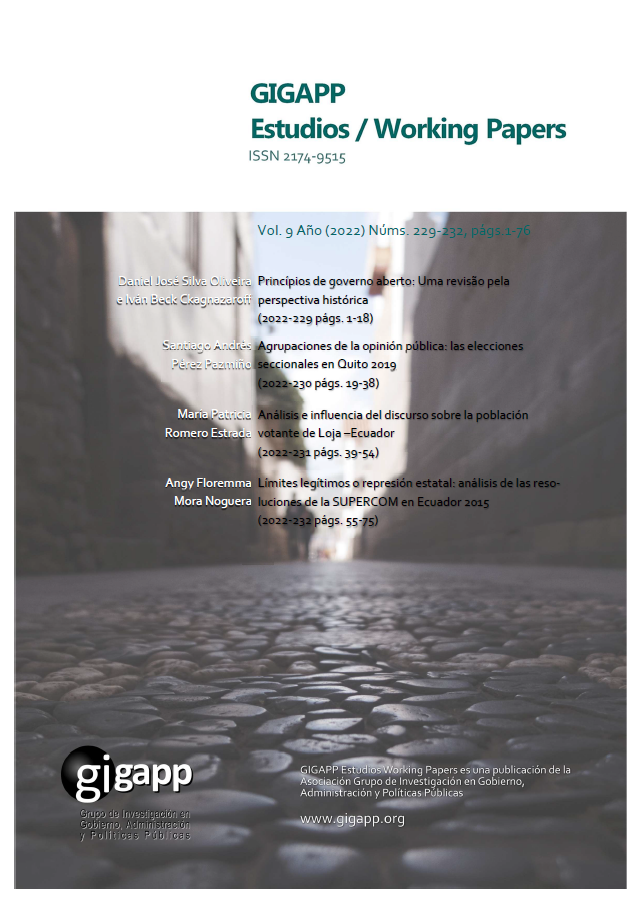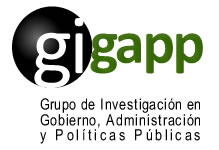Analysis and influence of the discourse on the voting population of Loja - Ecuador
Abstract
The objective of this article is to analyze the discourse, as well as to make known its influence first hand, this under the conception of the piece and tool used within the varied communication strategies in a political campaign. It is based on the hypothesis that the discourse, with a good story and exposition, of a strong emotional charge - although it is capable of capturing the attention of the public and inducing it to carry out actions - today it would be contributing very little in the image formation of a candidate, since the distant population would have a general negative perception towards politics.The research highlights this rejection especially in older people, compared to younger people who denote a better acceptance towards politics and, therefore, their attention to discourse.The main challenge of this research aims to awaken the search for innovative communicational political strategies, which make the discourse an attractive input, in front of an increasingly educated, participative, diverse audience and exposed to many contents; together with the advances in communication technology that massify and improve the possibilities of its impact.
Downloads
References
Antón, D.; (2018) Storytelling Cuánto cuenta contar en coaching. Madrid: Editorial Universitaria Ramón Areces.
Diario El Nuevo Herald (5 de Septiembre del 2019). Lo que transmite el lenguaje corporal: Alina Rubí. Recuperado de: https://www.elnuevoherald.com/opinion-es/article234749497.html
Durán, B.; Nieto, S.; (2011) El arte de ganar. Cómo usar el ataque en campañas electorales exitosas. Argentina: Editorial Sudamericana S. A.
Hernández, M; Rodríguez, I.; (2010) Comunicación no verbal y liderazgo. Claves para conseguirlo. España: Netbiblo.
Hernández, M.; Rodríguez, I.; (2009) Investigar en comunicación no verbal: Un modelo para el análisis del comportamiento kinésico de líderes políticos y para la determinación de su significación estratégica. enseñanza & Teaching, 27, 1-2009, pp. 61-94
Herrero, J.; Rodríguez, A.; (2008) El Candidato. Manual de relaciones con los medios. Sevilla: Comunicación Social ediciones y publicaciones.
Meyenberg, Y.; Lugo, J.; (2011) Palabra y Poder. Manual del Discurso Político. México: Grijalbo.
Muñoz, J.; Quintero, J.; Irízar. A.; (2009) El arte de hacer una campaña política. México: Estudios Estratégicos.
Navarro, J.; Karlins, M.; (2008) El cuerpo habla. Grandes secretos de la comunicación no verbal revelados por un ex agente del F.B.I. España: Editorial Sirio.
Navarro, P., (2014) Todo lo que deberías saber del lenguaje corporal. Recuperado de: https://habilidadsocial.com/el-lenguaje-corporal/
Nuñez, A.; (2010) ¡Será mejor que lo cuentes! Los relatos como herramientas de comunicación. España: Empresa activa.
Nuñez, A.; (2011) La estrategia del pingüino. Influir con mensajes que se contagian de persona en persona. España: Editorial Conecta.
Oropeza, R. (1992) Técnicas de Oratoria. México: Editorial Esfinge.
Ramírez, W., (2007) Manual del Marketing Político. República Dominicana: Editorial Lulu.com.
Redoli, D., (2015) Sin buenos discursos no se puede ganar ninguna batalla. Recuperado de: https://www.masconsulting.es/blog/2014/04/08/david-redoli-profesor-del-pdc-sin-buenos-discursos-politicos-no-se-puede-ganar-ninguna-batalla-politica-aunque-se-tenga-razon-en-los-contenidos/
Rodríguez, I.; Hernández, M.; (2010) Lenguaje no verbal. Cómo gestionar una comunicación de éxito. España: Netbiblo.
Salmón, C., (2016) Storytelling: La máquina de fabricar historias y fomentar las mentes. España: Grupo Planeta.
TedXUniversidadEuropeaMadrid (16 de Febrero del 2016). Nueva comunicación política: Alejandra Calvo Martínez.
Recuperado de: https://www.youtube.com/watch?v=RseL0Lm74Ao
Universidad de Navarra (26 de Febrero del 2016). El buen discurso político tiene ritmo, intensidad y naturalidad: David Redoli. Recuperado de: https://www.unav.edu/web/facultad-de-comunicacion/detalle-noticia2/2016/02/26/el-buen-discurso-politico-tiene-ritmo-intensidad-y-naturalidad/-/asset_publisher/ngL9/content/2016_02_24_com_david_redoli/10174
Copyright (c) 2022 María Patricia Romero (Autor/a)

This work is licensed under a Creative Commons Attribution-NonCommercial-ShareAlike 4.0 International License.
Those authors who have publications with this journal, accept the following terms:
a. Authors will retain their copyrights and guarantee the journal the right of first publication of their work, which will be simultaneously subject to the Creative Commons Attribution-NonCommercial-ShareAlike 4.0 International (CC BY-NC-SA Recognition License). 4.0) that allows third parties to share the work as long as its author and its first publication are indicated in this journal.
Under this open access license, readers (users) can:
- Share — copy and redistribute the material in any medium or format
- Adapt — remix, transform, and build upon the material
Under the following terms:
-
Attribution — Users must give appropriate credit, provide a link to the license, and indicate if changes were made. You may do so in any reasonable manner, but not in any way that suggests the licensor endorses you or your use.
-
NonCommercial — Users may not use the material for commercial purposes.
-
ShareAlike — If remix, transform, or build upon the material, users must distribute your contributions under the same license as the original.
- No additional restrictions — Users may not apply legal terms or technological measures that legally restrict others from doing anything the license permits.
b. Authors may adopt other non-exclusive license agreements for the distribution of the version of the published work (eg: deposit it in an institutional telematic archive or publish it in a monographic volume) provided that the initial publication in this journal is indicated.
c. Authors are allowed and recommended to disseminate their work through the Internet (e.g. in institutional telematic files or on their website) before and during the submission process, which can lead to interesting exchanges and increase citations of the published work. (See The effects of open access).



